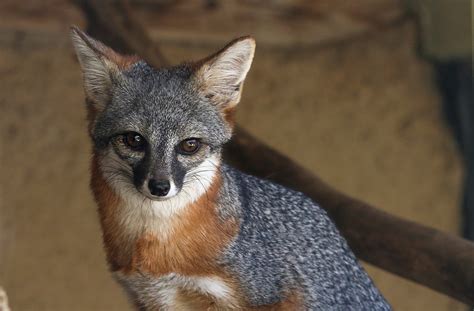The Channel Island Fox is a remarkable and unique species that has garnered significant attention due to its distinctive characteristics and intriguing history. Found exclusively on the Channel Islands off the coast of California, this small fox has adapted to its insular environment in fascinating ways, showcasing a high degree of resilience and versatility.
One of the most striking aspects of the Channel Island Fox is its size. These foxes are significantly smaller than their mainland relatives, a phenomenon known as island dwarfism. This reduction in size is believed to be an adaptation to the limited resources available on the islands, where the availability of food and space is more constrained compared to larger landmasses. Despite their small stature, Channel Island Foxes are incredibly resourceful, feeding on a wide range of food sources including fruits, insects, birds, and small mammals.
The evolutionary history of the Channel Island Fox is closely tied to the geographical history of the Channel Islands themselves. It is believed that these foxes originated from mainland gray foxes that were swept out to sea, possibly on debris or ice rafts, thousands of years ago. Over time, these isolated populations evolved into distinct species, each adapted to the specific conditions of their respective islands. There are six subspecies of Channel Island Fox, each found on a different island: Santa Cruz, Santa Catalina, San Miguel, Santa Rosa, Santa Barbara, and San Nicolas.
Conservation efforts have become a critical aspect of protecting the Channel Island Fox. In the early 2000s, the populations of these foxes were drastically declining due to a combination of factors, including predation by golden eagles, which had begun to nest on the islands after the decline of the native bald eagle and the introduction of non-native species such as pigs and sheep that competed with the foxes for food. The situation was so dire that by 2004, there were only about 50 foxes remaining on Santa Cruz Island, for example.
However, thanks to concerted conservation efforts, including the removal of non-native predators, captive breeding programs, and educational campaigns, the populations of Channel Island Foxes have begun to recover. The introduction of bald eagles back to the islands has also helped, as these eagles prey on golden eagles, thus reducing their impact on the fox population. As of the last surveys, the numbers of Channel Island Foxes have increased significantly, with some islands reporting populations in the hundreds, a remarkable turnaround from the brink of extinction.
The study of the Channel Island Fox provides valuable insights into evolutionary biology, conservation, and the complex dynamics of island ecosystems. These foxes serve as a prime example of how species can adapt to unique environments in remarkable ways, and how concerted conservation efforts can make a significant difference in the fate of endangered species. Their story underscores the importance of preserving biodiversity and the delicate balance of ecosystems, especially in isolated and fragile environments like the Channel Islands.
In exploring the world of the Channel Island Fox, one is reminded of the intricate web of life and the interconnectedness of species within an ecosystem. The conservation of this species is not just about saving a charismatic animal; it’s also about preserving the health of the islands’ ecosystems, which are rich in biodiversity and have much to teach us about resilience and adaptation.
For those interested in learning more about conservation and the fascinating world of island species, there are numerous resources and organizations dedicated to these causes. Whether through volunteering, supporting conservation groups, or simply spreading awareness about the importance of biodiversity, every effort counts in the pursuit of preserving our planet’s precious wildlife and ecosystems.
What is island dwarfism, and how does it affect the Channel Island Fox?
+Island dwarfism is a phenomenon where species that live on islands evolve to be smaller than their mainland counterparts. This is often due to the limited resources available on islands. For the Channel Island Fox, island dwarfism means they are smaller than mainland gray foxes, which is an adaptation to the constrained food and space resources on the islands.
Why are Channel Island Foxes important for the ecosystem of the Channel Islands?
+Channel Island Foxes play a crucial role in maintaining the balance of the ecosystem on the Channel Islands. They act as both predators and prey, controlling populations of smaller animals and serving as a food source for larger predators like eagles. Their presence is vital for the health and diversity of the islands' ecosystems.
What conservation efforts have been most effective in helping the Channel Island Fox recover from the brink of extinction?
+The most effective conservation efforts for the Channel Island Fox have included the removal of non-native predators, captive breeding programs, and reintroduction efforts. Additionally, the restoration of native species and the removal of introduced species that compete with the foxes for resources have been critical. Education and outreach programs have also played a significant role in raising awareness and supporting these conservation efforts.
In conclusion, the Channel Island Fox is a remarkable species that offers insights into adaptation, conservation, and the complexities of island ecosystems. Their story serves as a beacon of hope for conservation efforts worldwide, demonstrating that with dedication and the right strategies, it is possible to bring species back from the edge of extinction and preserve the delicate balance of our planet’s ecosystems. As we continue to face the challenges of biodiversity loss and ecosystem degradation, the tale of the Channel Island Fox reminds us of the importance of our actions and the power of collective effort in making a difference for the future of our planet.



